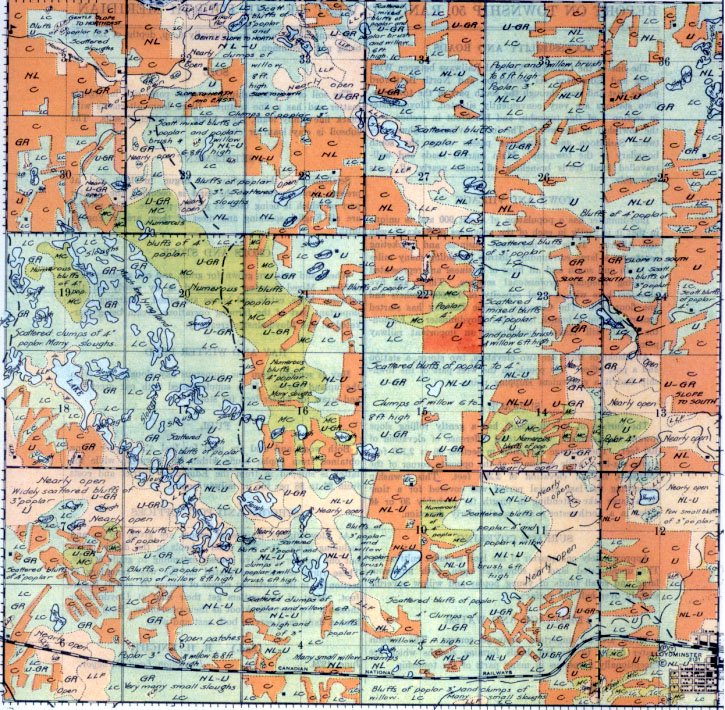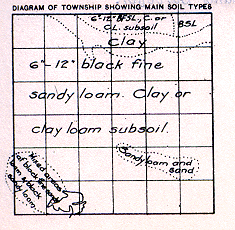


REPORT ON TOWNSHIP 50, RANGE 1, WEST OF THE FOURTH MERIDIAN
ACCESSIBILITY AND ROADS
The line of the Canadian National Railways between Winnipeg and Edmonton via Saskatoon and North Battleford passes east and west through the south part of the township. Two stations are very conveniently situated, Lloydminster in section 1 of this township and Blackfoot in section 1 of the township to the west. The interprovincial highway between Saskatoon and Edmonton passes along the south boundary of the township. Main market roads and well-travelled local roads branching off make nearly all parts accessible.
TOWN AND VILLAGE
Lloydminster has a population of about 900 and is unique in that it is partly in each of the provinces of Saskatchewan and Alberta. It is an important business and marketing centre for a large surrounding district extending many miles to north and south and all lines of business are represented including adequate professional services. There are five elevators here with a total capacity of 140,000 bushels and one flour mill. The Canadian Pacific Railway has started construction on a branch line from Lloydminster to Edmonton which will make Lloydminster an important railway point.
At Blackfoot there are two elevators, two stores, a station and a post office. The people in the west part of the township find it a convenient shipping point.
SURFACE
The surface of this township has a gently rolling slope toward the northeast, with a total difference of elevation of 100 feet. The
average elevation in section 36 is 2,100 feet above sea-level while section 6, at the opposite corner of the township, has an elevation of 2,200 feet. This township succeeding the last glacial period was covered for a time by a large lake extending in length for probably 30 or 40 miles in a northwesterly and southeasterly direction.
SURFACE COVERING
Approximately one-quarter of the land is under cultivation. The uncultivated land is somewhat open, with numerous large and small bluffs of young poplar and willow covering 1 slightly over half the surface.
DRAINAGE AND WATER
There are no important drainage courses. The surplus water drains to the low lands forming sloughs which are exceptionally numerous in many parts of the township. In some places wells are unusually deep, depths of 150 feet being not uncommon.
CROPS AND STOCK
Wheat and oats are grown for grain, and oat greenfeed for fodder. Mixed farming is engaged in by nearly all the settlers. Hogs, cattle and horses are raised. Dairying is an important part of the farming operations, cream being marketed at the Lloydminster creamery.
FUEL
Both wood and coal are used for fuel, the former being obtained from poplar bluffs within the township while the latter is shipped in from the Edmonton district and costs from $6 to $8 per ton at railway points.
SOIL
The soil of this township is in most parts rich in organic matter and has a fine texture. Black loam alternates with black fine sandy loam, these being the principal soils. The subsoil is clay loam or clay.
SETTLEMENT
Settlement in this locality was begun in 1903 and at present three-quarters of the land is occupied the greater part of which is being used as private pasture. The settlers are all English-speaking and most of them are of English birth.
HAY AND WINT ER FEED
Hay is secured from the numerous hay sloughs and from the upland prairie. It is supplemented with oat greenfeed and straw for winter feed for stock.
SCHOOLS AND POST OFFICES
At Lloydminster courses at school are given up to and including grade 11. The other schools in the district have but one teacher and give courses extending to grade 8 only. These rural schools are located on the west boundary of section 31, in the northeast comer of section 22, and at Blackfoot. Most of the settlers get their mail at Lloydminster though a few have Blackfoot as their post office. Both points have a daily mail service both east and west.
June, 1924.
(Sgd.)
R. H. KNIGHT,
Dominion Land Surveyor.



